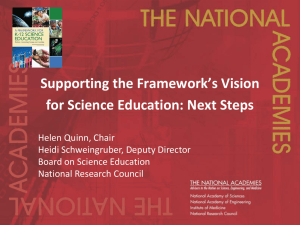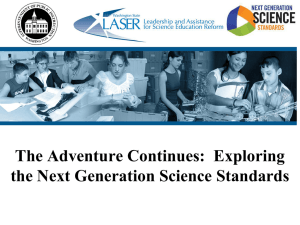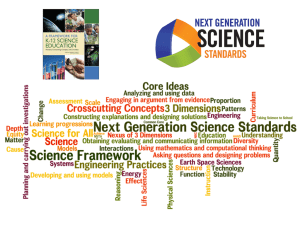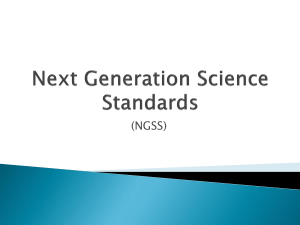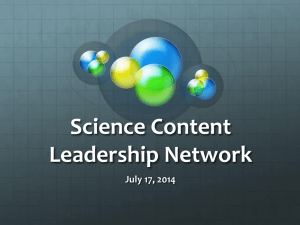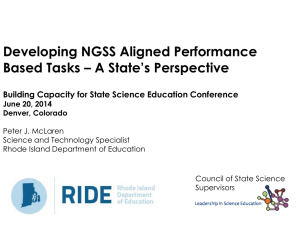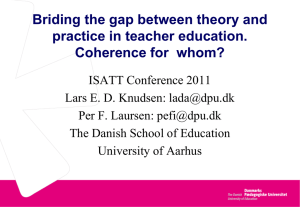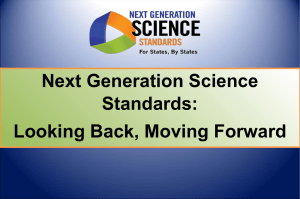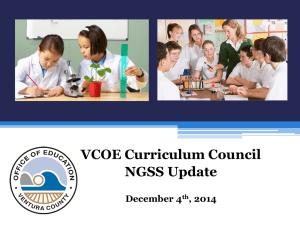A New Conception of Proficiency in Science
advertisement
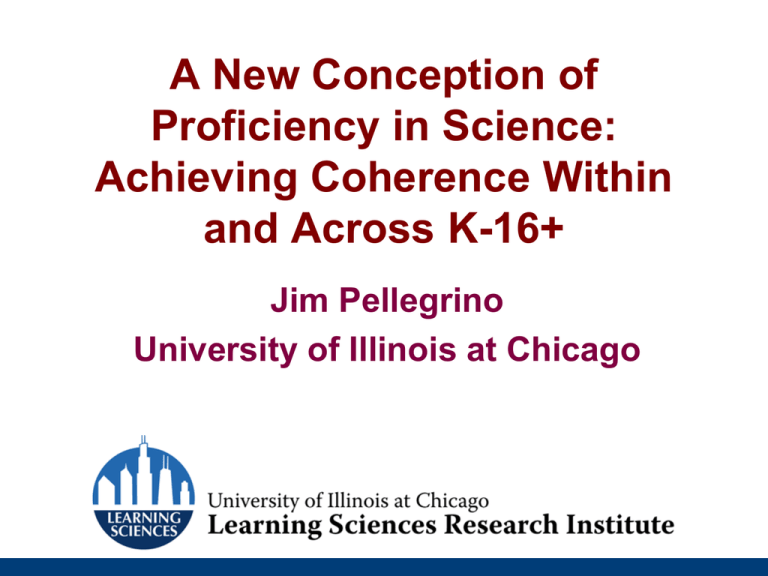
A New Conception of Proficiency in Science: Achieving Coherence Within and Across K-16+ Jim Pellegrino University of Illinois at Chicago Foci of Today’s Presentation • Achieving Coherence: Past, Present, Future? • Defining Competence to Achieve Coherence – Unpacking the Components of Competence • From NGSS Performance Expectations to Coherence in K-12 Science Education • Beyond K12: From NGSS to AP to MCAT • Final Thoughts Aligning Curriculum, Instruction & Assessment Standards Standards & Frameworks as Guides for Reform in K-12 Science Assessments 1990s-2009 Curriculum Materials 1990s Classroom teaching Teacher development 1/2010 - 7/2011 7/2011 – 3/2013 Issues in U.S. Science Education • Multiple sets of standards – 50 states • Lack of coherent instructional sequences – topics and modules -- mix and match • Lots of “hands-on” but little “minds-on” inquiry activities in modules and kits • Focus on declarative knowledge on tests • Focus on “scientific method” absent content • Poor performance on NAEP science • Poor performance on PISA science Foci of Today’s Presentation • Achieving Coherence: Past, Present, Future? • Defining Competence to Achieve Coherence – Unpacking the Components of Competence • From NGSS Performance Expectations to Coherence in K-12 Science Education • Beyond K-12: From NGSS to AP to MCAT • Final Thoughts New Definition of Competence • The NRC Science Framework has proposed descriptions of student competence as being the intersection of knowledge involving: – important disciplinary practices – core disciplinary ideas, – and crosscutting concepts with – performance expectations representing the intersection of the three. • It views competence as something that develops over time & increases in sophistication and power as the product of coherent curriculum & instruction A Core Idea for K-12 Science Instruction is a Scientific Idea that: • Has broad importance across multiple science or engineering disciplines or is a key organizing concept of a single discipline • Provides a key tool for understanding or investigating more complex ideas and solving problems • Relates to the interests and life experiences of students or can be connected to societal or personal concerns that require scientific or technical knowledge • Is teachable and learnable over multiple grades at increasing levels of depth and sophistication Life Sciences Explanatory Core Ideas • LS1: From molecules to organisms: Structures and processes – How do organisms live, grow, respond to their environment, and reproduce? • LS2 Ecosystems: energy, dynamics LS1.A: HowInteractions, do the structures ofand organisms – Howenable and why do organisms life’s functions?interact with their environment? What are the effects of these interactions? LS1.B: How do organisms grow and develop? • LS3 Heredity: Inheritance and variation of traits LS1.C: How do organisms obtain and use the – How are characteristics of one generation passed on? Why do matterdiffer? and energy they need to live and grow? individuals LS1.D How do organisms detect, process, and • LS4 Biological evolution: Unity and diversity use information about the environment? – How can there be so many similarities among organisms yet so many different kinds of plants, animals, and microorganisms? Key Role of Scientific Practices • Developing explanatory core ideas requires engaging in practices to build, synthesize, apply, and refine the ideas over time. • “Standards should include performance expectations that integrate the scientific and engineering practices with the crosscutting concepts and disciplinary core ideas. These expectations should require that students demonstrate knowledge-in-use and include criteria for identifying successful performance.” (NRC 2011, Rec 5). Scientific and Engineering Practices 1. Asking questions and defining problems 5. Using mathematics and computational thinking 2. Developing and using models 6. Developing explanations and designing solutions 3. Planning and carrying out investigations 4. Analyzing and interpreting data 7. Engaging in argument from evidence 8. Obtaining, evaluating, and communicating information Evolution from Inquiry Standards to Scientific Practices Social Interaction and Discourse Emphasis on Knowledge Building Inquiry Inquiry Crosscutting Concepts • Some important themes pervade science, mathematics, and technology and appear over and over again, whether we are looking at an ancient civilization, the human body, or a comet. They are ideas that transcend disciplinary boundaries and prove fruitful in explanation, in theory, in observation, and in design. — American Association for the Advancement of Science 1. 2. 3. 4. 5. 6. 7. Patterns Cause & Effect: Mechanism & Explanation Scale, Proportion & Quantity Systems and System Models Energy & Matter: Flows, Cycles and Conservation Structure and Function Stability and Change Coherence across K-12 Learning complex explanatory ideas… • …unfolds over time • …requires revisiting core ideas in new contexts that force students to extend them • …requires that students engage in tasks that force them to synthesize and apply ideas “Standards should be organized as progressions that support students’ learning over multiple grades. They should take into account how students’ command of the concepts, core ideas, and practices becomes more sophisticated over time with appropriate instructional experiences.” (NRC 2011, Rec. 7) A Progression of Explanatory Ideas 9-12 Molecular model of biochemical reactions for matter and energy in food. 6-8 3-5 K-2 Chemical reactions model for matter and energy in food, drawing on particle model of matter and energy transfer model. Simple food model: food consumed or produced is made of matter and provides energy for organisms. General needs model: Organisms get what they need to survive from the environment. NRC Framework’s Goals for Teaching & Learning • • • Coherent investigations of core ideas across multiple years of schooling More seamless blending of practices with core ideas Performance expectations that require reasoning with core disciplinary ideas – explain, justify, predict, model, describe, prove, solve, illustrate, argue, etc. Crosscutting Concepts Practices Core Ideas Foci of Today’s Presentation • Achieving Coherence: Past, Present, Future? • Defining Competence to Achieve Coherence – Unpacking the Components of Competence • From NGSS Performance Expectations to Coherence in K-12 Science Education • Beyond K-12: From NGSS to AP to MCAT • Final Thoughts Two Major Features of the NGSS • Built on the idea of Progressions in the Sophistication of Student Understanding as previously articulated in the NRC Framework • Include a new “Architecture” with a focus on Performance Expectations that draw from the intersections of disciplinary core ideas, science and engineering practices, and cross-cutting concepts A New Architecture for Expressing Standards Pluses & Minuses of Relying on Performance Expectations + Avoid vague cognitive verbs – “know” & “understand” + Stated as claims about students in terms of what they are supposed to be able to do to demonstrate their knowledge + Identify progressions as part of expectations - Don’t tell us how to get there – curriculum materials and instructional practices - Need to be “unpacked” in terms of the forms of evidence needed to support the student claim NGSS as the Basis for Aligning C-I-A NRC Framework & NGSS Some Challenges for Curriculum and Instruction • Build coherently in a given grade and across grades • Provide time for students to engage in the practices and explore ideas in depth • Provide support for students to become proficient with the practices • Create opportunities for students to interact with each other in productive ways • How to integrate engineering • How to support and include Language Learners Some Challenges for Professional Development • Practices may be unfamiliar to teachers • Knowledge of crosscutting concepts and some core ideas may be incomplete for some teachers • Thinking about learning progressions within and across grades • Some teachers will need to make major changes in instructional approach • Making connections across disciplines and to mathematics and ELA • Others…… Challenges for Assessment (and Curriculum & Instruction) • To develop situations and tasks that integrate the three dimensions. • To develop situations and tasks that can assess where a student can be placed along a sequence of progressively more complex understandings of a given core idea, and successively more sophisticated applications of practices and crosscutting concepts. • To develop situations and tasks that assess the connections between the different strands of disciplinary core ideas (e.g. using understandings about chemical interactions from physical science to explain phenomena in biological contexts). Three Important Questions 1. Is this an impossible task given the size and scope of the changes necessary? 2. How does this relate to college and career ready and to STEM ready in higher ed? 3. Is there somewhere we can look for help in figuring this out? Foci of Today’s Presentation • Achieving Coherence: Past, Present, Future? • Defining Competence to Achieve Coherence – Unpacking the Components of Competence • From NGSS Performance Expectations to Coherence in K-12 Science Education • Beyond K-12: From NGSS to AP to MCAT • Final Thoughts Published in Feb 2011 Published in Fall 2011 Structure of the AP Biology Curriculum Framework 4 Big Ideas Enduring Understandings Essential Knowledge Science Practices: Science Inquiry & Reasoning Learning Objectives Curriculum Framework: Big Ideas The unifying concepts or Big Ideas increase coherence both within and across disciplines. A total of Four Big Ideas: 1 The process of evolution drives the diversity and unity of life. BIG IDEA 2 Biological systems utilize energy and molecular building blocks to grow, reproduce, and maintain homeostasis. BIG IDEA 3 Living systems retrieve, transmit, and respond to information essential to life processes. BIG IDEA 4 Biological systems interact, and these interactions possess complex properties. BIG IDEA Building Enduring Understandings For each Big Idea, there are enduring understandings which incorporate core concepts that students should retain. Total of 17 enduring understandings across the four Big Ideas. BIG IDEA 1 The process of evolution drives the diversity and unity of life. Enduring Understanding 1.A: Change in the genetic makeup of a population over time is evolution Enduring Understanding 1.B: Organisms are linked by lines of descent from common ancestry Enduring Understanding 1.C: Life continues to evolve within a changing environment Enduring Understanding 1.D: The origin of living systems is explained by natural processes AP Science Practices: Level 1 1. Use representations and models to communicate scientific phenomena and solve scientific problems. 2. Use mathematics appropriately. 3. Engage in scientific questioning to extend thinking or to guide investigations within the context of the AP course. 4. Plan and implement data collection strategies in relation to a particular scientific question. 5. Perform data analysis and evaluation of evidence. 6. Work with scientific explanations and theories. 7. Connect and relate knowledge across various scales, concepts, and representations in and across domains. AP Integrating the Content and Science Practices Content + Science Practice Learning Objective Essential Knowledge 1.B.2 Phylogenetic trees and cladograms are graphical representations (models) of evolutionary history that can be tested Science Practice 5.3 The student connects phenomena and models across spatial and temporal scales Learning Objective (1.B.2 & 5.3) The student is able to evaluate evidence provided by a data set in conjunction with a phylogenetic tree or a simple cladogram to determine evolutionary history and speciation What’s The Impact Of Curriculum Changes On New AP Biology Exam? Because of use of Big Ideas….in 2008, 12% of questions had something to do with evolution In new exam, 35% of questions have something to do with evolution Because of emphasis on science practice and mathematical skills…new types of questions are being asked, e.g., grid-ins Because of use of evidence…the number of Multiple Choice questions was reduced from 100 questions on last year’s exam to 63 on this year’s exam. The New AP Exam No test items will focus on low cognitive level/declarative knowledge/recall For each exam item, students will either produce the evidence (CR) or engage with the evidence (SR/MC) explain ►justify ►predict ►evaluate ►describe ►analyze ► pose scientific questions ►construct explanations ►construct models ►represent graphically ►solve problems ►select and apply mathematical routines ► Foci of Today’s Presentation • Achieving Coherence: Past, Present, Future? • Defining Competence to Achieve Coherence – Unpacking the Components of Competence • From NGSS Performance Expectations to Coherence in K-12 Science Education • Beyond K-12: From AP to MCAT • Final Thoughts What’s Left to Do? – A LOT!!! • We need to translate the standards into effective models, methods and materials for curriculum, instruction, and assessment. – Need to unpack & clarify performance expectations – Need precise claims & evidence statements – Need task models & templates • We need to use what we know already to evaluate and improve the assessments that are part of current practice, e.g., classroom assessments, large-scale exams, etc. Science Assessment: Grand Challenges Will We Have Assessments Worth Teaching With & To? • Desires and timelines of the policy community may conflict with the capacities of the R&D & Practice communities – Worst thing we could do is leap to designing a new “NGSS Aligned” High Stakes Test • Standards are the beginning not the end – not a substitute for the thinking and research needed to define progressions of learning that can serve as a basis for the integration of curriculum, instruction and assessment. Assessment Should not be the “Tail Wagging the Science Education Dog” NGSS Assessment Voltaire “The perfect is the enemy of the good."

